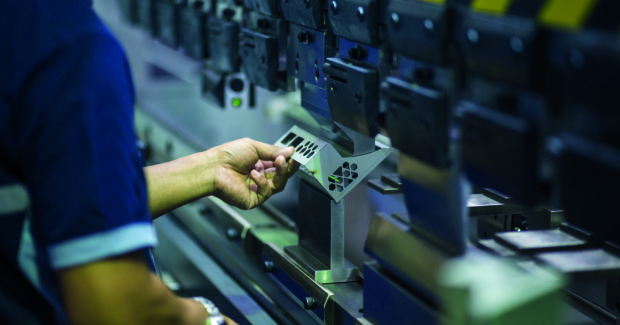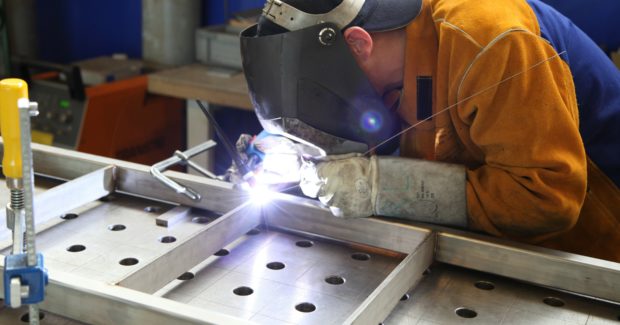The Rise of the Digital Prototype
Sky-high material costs and skill shortages highlight the need for virtual prototyping.
Posted: August 23, 2022
While highly efficient machinery continues to help fabricators increase productivity, it’s safe to say that the industry has just about reached the limits of how fast we can cut or bend parts without throwing quality out the window. Even as machinery and the software that drives it continue to advance, we now stand to reach the heights of efficiency not by working at breakneck speed but by fine-tuning processes on the journey from art to part.
With material costs having doubled in the past year in response to a laundry list of global challenges, the days of churning out and physically testing any number of prototypes are firmly in our rear view. Amplifying the need for new methods of proving out parts and processes are demand for increasingly complex bent parts and the absence of seasoned press brake operators who understand the art and science of fabrication.
While these hurdles can cloud our chances of success, the availability of digital tools that enable us to eliminate the resource-draining loop of physical prototyping is a significant silver lining. Computer-aided design (CAD) and computer-aided manufacturing (CAM) software developed to address problems common to fabrication offer tools, such as those that drastically simplify assembly, to help make parts more manufacturable.
CAD and CAM software dedicated to helping fabricators easily resolve common shop floor challenges is capable of accurately simulating processes by accounting for specific job parameters, materials and equipment. These tools help reduce the scrap heap by providing reliable digital prototyping that optimizes time, materials and labor.
Design for Manufacturing
CAD for manufacturing software helps fabricators rethink part design to determine if components can be made more quickly and easily, which can reflect cost savings shared with customers for increased competitiveness. While collaboration with customers is typically required for significant changes, fabricators are often free to make small, invisible adjustments that make parts easier to produce, and at less cost.
For example, combining two separate parts that would ultimately require welding into a single component reduces processing time by eliminating secondary operations. Similarly, a fabricator could opt to bend an area that would otherwise need to be welded to reduce both time and labor. Manufacturing-focused design software makes these changes easier to perform, which speeds up the transition from planning to production.
CAD and CAM tools that optimize design for manufacturing take a practical approach by first determining if the part can be made with the tools already at the fabricator’s disposal. If you cut 250 parts before discovering they cannot be bent with your press brake, that’s a problem that your software should have identified prior to production.
While traditional CAD software relies on the fabricator to supply the material’s often tricky K factor — a numerical ratio used to mathematically model the behavior of sheet metal being bent — intelligent software designed for transitioning easily to production ‘learns’ about the tools used for working with a specified material. CAD-for-manufacturing software is also much better than traditional CAD solutions at virtually bending a part that has been digitally unfolded and accounting for material behavior and mechanical performance that may result in spring back, wrinkling, tearing and cracking.
This specialized CAD software also provides production-specific options that aid with assembly. One such option is the creation of a tenon, or a tab on the end of a tube that’s designed to fit into the slot of another tube. Invisible to the customer once the components are finished, tenons help ensure that parts are assembled correctly. As tenons help join parts, greater stability is created during assembly and components can be easily welded together by a single employee for reduced labor and opportunity for error.
An added benefit of using tenons is that they make it impossible to assemble components incorrectly, which ensures that fabricators won’t discover after welding that an assembly was put together backward. Similarly, etching part numbers onto components for identification can significantly speed up the labor-intensive sorting process and eliminate misidentification errors.
Design for Assembly: Watson Gym Equipment
U.K.-based Watson Gym Equipment works exclusively in the fitness industry, supplying strength equipment to high-end PT gyms for training professional and Olympic athletes. Its product range of roughly 200 machines are manufactured from sheet metal and box-section steel.
A partnership between the company’s CNC machine tool supplier and CAM software provider transformed the way it cuts box section steel using a laser tube cutter powered by tube processing software. A major advantage of the CAM software is that it enables tabs to be created in a style that the apparatus can only be put together one way.
“We use different sized tabs and make them non-symmetrical, so when the welder comes to fit the pieces together it’s like a jigsaw puzzle, completely eliminating human error at the assembly stage,” said Watson Gym Equipment’s Managing Director Simon Watson.
Rethinking the Prototyping Loop
Because sheet metal components are relatively simple to produce, material optimization is a cornerstone of success for any fabrication outfit. While a typical OEM may anticipate paying a high price for an impeller machined in Inconel, customers expect the price of fabricated parts to remain relatively low despite rising material costs.
Fabricators struggling to shoulder skills gaps and the brunt of higher prices are left with little to benefit from physical prototyping that’s unlikely to succeed without the help of a skilled press brake operator. The challenge in eliminating reliance on physical prototypes, however, is in being confident that that we can truly rely on digital prototyping to help us produce components right the first time.
To produce a design that can be correctly manufactured right out of the gate, CAD and bending software work in combination to optimize both the design and process. For virtual prototyping, a design can be run through bending software for analysis of the process and all production parameters and, if that process isn’t optimal, adjustments can be made using the CAD solution until a balance between the job specifications and capabilities of the fabricator are achieved.
Finding this balance entails considering where we want to spend our time and resources, and our CAD and bending software can help create a roadmap for completing the job. For instance, whether a punch press or laser is used to cut parts will shape how much additional work is required. A corner may be less expensive to make on a punch press, but the subsequent welding and polishing will be more challenging than if a laser were used.
Digitally prototyping and proving processes eliminates the painstakingly slow and inefficient traditional method of cutting a part and handing it off to the press brake operator to see if it can be bent in line with job requirements. This frustrating process requires the time of the operator and the machines needed for cutting and bending. If a physical test performed by the press brake operator doesn’t work the first time, the prototyping loop begins all over again.
Developed to respond to challenges specific to increasingly complex and customized sheet metal manufacturing, robust digital tools are available now to combat the all-too-common problems that cause bottlenecks and diminish efficiency. Slowing down to examine how we can make designs more manufacturable to ultimately increase the speed of production may seem counterintuitive but adjusting how we work to meet the needs of the moment is what manufacturers do best.
Subscribe to learn the latest in manufacturing.













